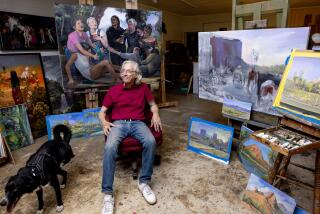An Artist Auctions His Junkscape
- Share via
DETROIT — The wooden block painted with four grinning faces went for $350. The blue work shoe filled with cement was snatched up for $170. But as he dismantled his famed urban junkscape at an open-air auction on Saturday, artist Tyree Guyton found there were some pieces he couldn’t bear to part with.
The dollhouse stuffed with broken, naked plastic babies stayed. So did the old TV set splashed with pink and yellow paint. Guyton plans to sell them off this summer. He just couldn’t do it quite yet.
“It’s like tearing apart your heart and soul,” said his creative partner, Jenenne Whitfield.
Guyton has spent the last 17 years transforming the rotting homes of his impoverished neighborhood into canvases of riotous -- some neighbors say hideous -- color. He has covered buildings, sidewalks, trees and lawns with sculptures made from junk: high-heeled shoes glued to rooftops, old toilets set on the grass, plastic jugs and shattered clocks and bald tires painted over with his trademark polka-dot motif.
The city has bulldozed several of his creations. Tourists by the tens of thousands have flocked to Heidelberg Street on Detroit’s rough East Side to see the rest.
“It’s the SoHo of Detroit,” said Tim Burke, who bought three plywood paintings Saturday as Guyton began taking apart his most celebrated work -- the OJ House -- piece by piece.
Created in 1995, as the O.J. Simpson murder trial captivated the nation, the OJ House was Guyton’s eye-popping statement on justice, celebrity, brutality, wealth -- and a society he sees as adrift, without moral purpose.
The broken dolls symbolize domestic violence. The paint-smeared TVs speak to the media’s blind obsession with fame. The cash register on the porch stands for Guyton’s view that money, not truth, matters most in this world. Nearly every inch of the abandoned two-story house is covered with Guyton’s paintings, his found-in-a-Dumpster treasures, or the spray-painted acronyms (LAPD, DNA) that in 1995 seemed so monumental.
“It raises all kinds of emotions about civil rights, justice, art and humanity,” said Andrew Strahan, 29, a city resident who paid $200 for a chunk of metal painted with a face.
Guyton has been adding to the OJ House these last eight years but says now that “it’s time to move on.”
He plans to renovate the house -- if he can raise $200,000 -- and turn it into a community center with a children’s gallery and a studio for visiting artists. He also plans to cover it, from top to bottom, with pennies, dubbing it “The House That Makes Sense.”
“We’re trying to help kids imagine their way out of this blight,” Guyton said last week, as neighborhood children painted turquoise polka dots on the sidewalk at his feet. “They grow up surrounded by decay, so we want to make this a fun place, a place full of color.”
“We’re teaching them that life is not perfect, but you have it within you to use your imagination to change it for the better,” Whitfield added.
Before the pennies can go up, though, the old artwork has to come down.
So, to the accompaniment of poetry readings, Guyton hosted a block-party auction that drew dozens of his fans to Heidelberg Street for good-natured, low-key bidding.
Though his works are usually priced at several thousand dollars apiece, Guyton sold 36 autographed pieces right off the house for a total of $7,480 that will go to the penny project. Most bidders were longtime fans of his work -- eager to buy a chunk of painted metal or a doll pinned to a cross not only for its aesthetic appeal, but for the chance to own a piece of history.
“I have a special feeling for the whole street, and now I have a part of it. I like the idea that he makes art out of nothing,” said Fran Goldsmith, who came to the auction from the wealthy suburb of West Bloomfield.
“It’s some of the most magical art I’ve seen,” added Allen Bukoff, 51, another bidder in from the suburbs.
Yet not everyone appreciates Guyton’s style.
“Don’t tell me it’s art, because it’s junk,” said Betty Howell, 64, who lives around the corner from Heidelberg. “If it’s that wonderful, give him an art museum and let him clean up the street.”
The city had tried to clean up Heidelberg once, in the fall of 1991, sending bulldozers to knock down four of the abandoned houses Guyton had decorated.
The artist responded by turning the vacant lots into sculpture gardens, crammed with collections of junked furniture and an army of ancient vacuum cleaners.
“It’s ... different,” said Deborah Stewart, 51, who lives nearby.
She cast about for a more telling adjective. She couldn’t find one.
“What else can I say? It’s different.”
Stewart added that she appreciated the work for drawing so many visitors to the East Side. Yet junkscape tourism is not what Mayor Kwame Kilpatrick has in mind when he talks about revitalizing Detroit.
“Tyree is very creative, and his expression deserves a voice and an audience,” said the mayor’s spokesman, Jamaine Dickens. “But it’s our goal to serve the citizens of Detroit by cleaning up this city. At some point, our mission and his interpretation of art are going to be in conflict.”
Guyton, however, plans to keep on creating. He has produced public art projects on commission in Minnesota and New York; this summer, he will decorate a house in Australia. Most of the time, though, he hangs out on Heidelberg Street, throwing his energy into a neighborhood he is determined to uplift.
“This is a broken-down city with broken-down people,” Guyton said. “We want to do something about it.”
*
Times staff photographer Gary Friedman contributed to this report.
More to Read
Sign up for Essential California
The most important California stories and recommendations in your inbox every morning.
You may occasionally receive promotional content from the Los Angeles Times.













